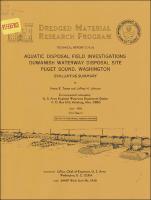Please use this identifier to cite or link to this item:
https://hdl.handle.net/11681/47609| Title: | Aquatic disposal field investigations, Duwamish Waterway disposal site, Puget Sound, Washington : evaluative summary |
| Authors: | Tatem, Henry E. Johnson, Jeffrey H. |
| Keywords: | Aquatic ecology Puget Sound (Wash.) Dredging Dredging spoil Dredged material Sedimentation and deposition |
| Publisher: | U.S. Army Engineer Waterways Experiment Station |
| Series/Report no.: | Technical Report (Dredged Material Research Program (U.S.)) ; no. D-77-24 |
| Abstract: | A multidisciplinary approach was utilized to study the physical, chemical, and biological effects of disposal of contaminated dredged material from the Duwamish River on a deepwater disposal site located in Elliott Bay, Puget Sound, Wash. A pilot survey, conducted in November and December 1975, was followed by ’ a full-scale field assessment program. Observation of individual disposal events indicated that the sediment left the split-hull barges as a well-defined slug and reached the bottom in approximately 25 sec. A mound of dredged material 2.2 m high was created near the center of the disposal site. There was no physical or chemical evidence which indicated that any of the material reached the two reference sites located east and west of the disposal site. Chemical analyses of the in situ river sediment revealed concentrations of total sulfides and PCB’s and interstitial water ammonia significantly higher than those for sediments from the disposal or reference sites. The disposal operation resulted in a rapid pulse of low levels of suspended solids in the water column which lasted less than 30 min. Increased levels of dissolved manganese and total PCB’s in the water column were associated with the short-term increase in suspended particulate matter. Chemical analyses of animal tissues collected at the disposal and reference sites indicated that the disposal operation did not result in higher levels of mercury and chromium in test animals. Mussels held at the disposal site for 3 weeks did accumulate PCB’s to some extent; however, Back-ground levels of PCB’s in Elliott Bay waters were found to be relatively high before the operation. No adverse effects on demersal fish or shellfish were demonstrated. These motile animals were found at the disposal site in large numbers during and after the disposal operation. Benthic communities at the center of the disposal site were impacted adversely. The density and biomass data from the central disposal site stations indicated fewer animals present after the disposal although the species data showed more species were present. The biomass and density of animals at the corner stations of the disposal site were found to be greater than the values determined for the two reference sites at 3 months after disposal. A number of opportunistic species were found to be actively recolonizing the central stations of the disposal site at 9 months after disposal. |
| Description: | Technical Report |
| Gov't Doc #: | Technical Report D-77-24 |
| Rights: | Approved for Public Release; Distribution is Unlimited |
| URI: | https://hdl.handle.net/11681/47609 |
| Appears in Collections: | Technical Report |
Files in This Item:
| File | Description | Size | Format | |
|---|---|---|---|---|
| Technical Report D-77-24.pdf | 3.41 MB | Adobe PDF |  View/Open |